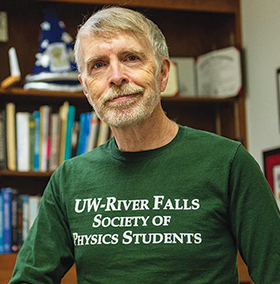Equity and Inclusion Matters
Fall
2020
Message from the President
Equity and Inclusion Matters
Earl Blodgett, SPS & ΣΠΣ Historian, Worth Seagondollar Service Awardee (’19), ΣΠΣ Honorary Member (’16), Professor of Physics, Director of STEMteach, Director of Undergraduate Research, Scholarly & Creative Activity at University of Wisconsin – River Fall
 When I was first approached about writing this opening letter, I experienced a touch of panic as I am no expert on equity and inclusion. I try to avoid the stereotypical hubris of physicists who seem to believe that being an expert in physics entitles them to be an expert on anything. I am a physicist, not a sociologist!
When I was first approached about writing this opening letter, I experienced a touch of panic as I am no expert on equity and inclusion. I try to avoid the stereotypical hubris of physicists who seem to believe that being an expert in physics entitles them to be an expert on anything. I am a physicist, not a sociologist!
Perhaps you feel the same way? Discussing issues like equity or racism may make you uncomfortable, and you might feel out of your depth. Interpersonal topics in general may be something you try to avoid (“Please don’t make us put our chairs in a circle!”).
But digging into a challenge is something that we are good at—after all, we are physicists! The key is that we enjoy the challenge of physics. It is in our personal comfort zone. I would submit for consideration the idea that we can make equity and inclusion something that can be enjoyable and mutually beneficial.
When you look around your own physics department, realize that everyone there brings a different background, experiences, and perspectives, some that are advantageous and some that are not. Inclusion means that we acknowledge and welcome those differences, not that we ignore them. Equity is the process of mutually providing each other with the support to remedy disadvantages by sharing from our advantages. I firmly believe that everyone has something of value to share in this process, because we all have gaps in our background and experiences. It is about being adaptable, respectful, and mutually supportive.
When I teach first-semester calculus-based physics, my students work in groups of three. I tell them that they are not competing for grades, that instead they are working together to improve everyone’s understanding. I remind them over and over that I don’t care what level of knowledge of physics they came into the class with. I care that they leave the class with a better understanding. This requires that students feel comfortable exposing their weaknesses and strengths so that everyone in the group leaves with a higher level of understanding. I think that this is an example of equity in action—providing a path to success for everyone by acknowledging and addressing the differing backgrounds and skills each student has coming into the class.
When schools focus on providing resources to fit individual needs, the entire classroom environment improves.1 I observe this in my classroom, my SPS chapter, and my community. We all benefit from recognizing our uniqueness and working together from that uniqueness. We can enjoy the process of learning from each other and supporting each other! Yes, equity and inclusion may be topics that you are not comfortable discussing, but continuing consideration of these issues is necessary to uphold the values we committed to as ΣΠΣ members. This is not something we, as a community, have done well in the past.
In March 2019, the National Council added to the existing SPS Statement on Diversity, Inclusion, Ethics, and Responsibility, emphasizing that we must actively correct for past exclusion in our community. Actually working together toward equity and inclusion can help address these historical injustices, can help us better understand one another, can be enlightening, and can be mutually beneficial!
1. OECD Observer Staff. Ten Steps to Equity in Education. Organization for Economic Co-operation and Development, January 2008, pp. 1–8.
